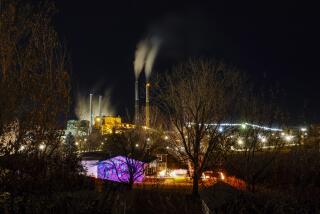Pumice Miner in National Forest Seeks to Buy Site--for $2.50 an Acre : Environment: Foes say the mine is damaging the area. They call the possible cheap purchase ‘a major rip-off of public land.’
LA CUEVA, N.M. — When Bob Crostic bought his first pair of stone-washed jeans recently, he discovered a small chunk of pumice in one of the pockets.
There was more than a bit of irony in the find.
Crostic, a U.S. Forest Service employee, oversees an open-pit pumice mine in the Santa Fe National Forest that is at the center of a noisy dispute about the use of public lands.
Because some of the pumice is used to stone-wash or acid-wash fabric, critics contend that the forest is being sacrificed for fashion, and “fashion versus forest” has become their rallying cry.
The Las Conchas Pumice Mine looks like a moonscape, the dazzling white of the pumice piles offset only by a couple of heaps of burned, blackened tree stumps.
“Great stuff to mine,” Crostic told recent visitors as he grabbed a handful of the lightweight, volcanic rock and sifted it through his fingers.
Last spring, as work began to prepare the mine site in northern New Mexico’s scenic Jemez Mountains, about 20 members of the environmental group Earth First! converged to protest the operation. Three were arrested when they locked themselves to earthmoving equipment.
At issue is a 19th-Century federal law that allows private citizens to mine and appropriate public lands at negligible cost.
The law, enacted to encourage mineral development, says that anyone who finds a valuable mineral deposit on public lands may stake a claim and mine it or patent the claim and purchase the land.
Although coal, oil, gas, sand, stone and other minerals have been removed from its provisions, the General Mining Law of 1872 still covers metals such as gold, lead, copper and zinc, as well as pumice.
Copar Pumice Co., which had staked claims in the area, received approval last summer from the Forest Service to strip-mine 33 acres in the national forest about 15 miles west of Los Alamos. Copar then must restore the site once mining is finished by recontouring it and planting grass and trees.
Environmentalists went to court, contending that the mine’s impact had not been adequately assessed, but mining continues while the case is pending.
In September, Copar owner Richard Cook applied for a patent, or outright ownership, of 1,700 acres surrounding the mine.
Under the 1872 law, if the tract is determined to contain valuable pumice, Cook can buy the land for $2.50 an acre. Once he owns the property, no state or federal reclamation laws would require him to restore the site after mining.
“It’s essentially a major rip-off of public land under an archaic law,” said Henry Oat of Santa Fe, who heads the East Fork Preservation Coalition.
The operating mine is barely a fourth of a mile from the East Fork of the Jemez River, a pristine trout stream that has been approved by Congress for inclusion in the National Wild and Scenic Rivers system.
Nearly 180 acres of the land Cook seeks fall within the quarter-mile corridor on either side of the river that would be protected by the federal designation, which awaits President Bush’s approval.
The legislation prohibits Cook from patenting the 180 acres along the river, but he cannot be prevented from mining it because he has valid claims. He has said, though, that he would not mine it because that would spoil the view from the river.
“We don’t intend to destroy the landscape or the area in any way,” he said from his office in Espanola.
Cook also said he has no plans for the 1,700 acres other than to mine it, but his opponents fear that he would develop condominiums or other commercial ventures in the forest.
Environmentalists also are worried that the beautiful Jemez area, a popular tourist destination, will turn into a pumice mining center.
The Copar pumice is the remnant of a volcanic explosion 150,000 years ago and is considered valuable because of its large chunks, its purity and its proximity to the highway.
Pumice goes into products ranging from building materials to toothpaste.
Its use as an industrial abrasive, including for stone-washing garments to give them an aged appearance, is a small but growing segment of the market, said Donna Smith, a mineral economist who lives near the mine.
Copar, however, is not a major pumice supplier to the garment industry. Cook said about 10% of the mine’s pumice goes for stone-washing, far less than was expected when the mine opened.
“The garment industry just isn’t taking all the large chunks now,” Cook said.
Most of Copar’s pumice is used for construction, he said.
Industry spokesmen say much of the pumice used by major garment manufacturers is imported.
Levi Strauss & Co., for example, buys its pumice from Turkey for its products that are stone- or acid-washed, and has cut back about 60% on the amount of pumice it uses, supplementing the stone with chemicals, said company spokesman David Samson in San Francisco.
Although only a fraction of Copar’s product ends up in the industrial machines in which denim is stone-washed, opponents of the mine have urged a boycott of stone-washed clothes.
The East Fork Preservation Coalition and other environmental groups also are pushing a proposal to have 115,000 acres, including the mine site, designated as a national recreation area, which they say would stop the patent process and offer greater protection for the forest.
There are also efforts to reform the 118-year-old mining law, including two bills that have been introduced in Congress to revamp it.
More to Read
Sign up for Essential California
The most important California stories and recommendations in your inbox every morning.
You may occasionally receive promotional content from the Los Angeles Times.










